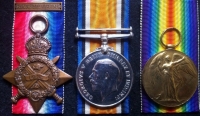
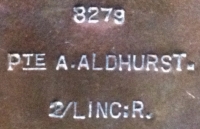
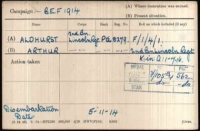



 [BIOGRAPHY]
Arthur Aldhurst was born in 1890 in the London Borough of Wandsworth, the fourth of seven surviving children of Benjamin Aldhurst, a former Gunner in the Royal Artillery.
Shortly after his 16th birthday Arthur decided to join the Militia, and on 10 December 1906 he enlisted in the 4th Battalion of the East Surrey Regiment. A year later, on 4 December 1907, he transferred to the Regular Army and enlisted in the Lincolnshire Regiment as 8279 Private Aldhurst. The 1911 Census shows him serving with the 1st Battalion in Aden.
By the outbreak of the First World War he was serving with the 2nd Battalion and landed with his unit in France on 5 November 1914.
The 2nd Lincolnshire Regiment was one of four regular battalions that formed the 25th Brigade which, together with the 23rd and 24th Brigades, formed the 8th Division. Following its arrival in France, the Battalion took over a stretch of the front line in the Laventie sector on 14 November 1914.
[BIOGRAPHY]
Arthur Aldhurst was born in 1890 in the London Borough of Wandsworth, the fourth of seven surviving children of Benjamin Aldhurst, a former Gunner in the Royal Artillery.
Shortly after his 16th birthday Arthur decided to join the Militia, and on 10 December 1906 he enlisted in the 4th Battalion of the East Surrey Regiment. A year later, on 4 December 1907, he transferred to the Regular Army and enlisted in the Lincolnshire Regiment as 8279 Private Aldhurst. The 1911 Census shows him serving with the 1st Battalion in Aden.
By the outbreak of the First World War he was serving with the 2nd Battalion and landed with his unit in France on 5 November 1914.
The 2nd Lincolnshire Regiment was one of four regular battalions that formed the 25th Brigade which, together with the 23rd and 24th Brigades, formed the 8th Division. Following its arrival in France, the Battalion took over a stretch of the front line in the Laventie sector on 14 November 1914.
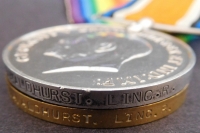
 [WOUNDED IN ACTION, NOVEMBER 1914]
During the next three days 6 men were killed and 17 wounded by shellfire (the Battalion War Diary refers). One of the wounded men was Private Arthur Aldhurst who was evacuated to England and admitted to the Military Hospital in Manchester on 21 November (the Grantham Journal of 5 December 1914 refers).
In the spring of 1915 the 2nd Lincolns were heavily engaged in the battles of Neuve Chapelle and Aubers Ridge during which they suffered 600 casualties. In June 1915 the Battalion moved to the Fleurbaix sector, and in the following nine months they suffered a further 600 casualties, including 334 in the diversionary attack at Bois Grenier on 25 September. At the end of March 1916 the 8th Division became part of III Corps in General Sir Henry Rawlinson’s Fourth Army and moved down to the Somme.
[WOUNDED IN ACTION, NOVEMBER 1914]
During the next three days 6 men were killed and 17 wounded by shellfire (the Battalion War Diary refers). One of the wounded men was Private Arthur Aldhurst who was evacuated to England and admitted to the Military Hospital in Manchester on 21 November (the Grantham Journal of 5 December 1914 refers).
In the spring of 1915 the 2nd Lincolns were heavily engaged in the battles of Neuve Chapelle and Aubers Ridge during which they suffered 600 casualties. In June 1915 the Battalion moved to the Fleurbaix sector, and in the following nine months they suffered a further 600 casualties, including 334 in the diversionary attack at Bois Grenier on 25 September. At the end of March 1916 the 8th Division became part of III Corps in General Sir Henry Rawlinson’s Fourth Army and moved down to the Somme.
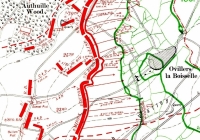 [1st JULY 1916, FIRST DAY BATTLE OF THE SOMME.]
On 1 July 1916 the 8th Division attacked the Ovillers spur, with the 23rd Brigade on the right advancing up Mash Valley, the 25th Brigade in the centre making a frontal assault on the village of Ovillers and the 70th Brigade on the left moving up Nab Valley. The leading battalions of the 25th Brigade were the 2nd Royal Berkshire Regiment and the 2nd Lincolnshire Regiment, with the 1st Royal Irish Rifles in support and the 2nd Rifle Brigade in reserve.
The 2nd Lincolns were in position by 03.30. At 06.25 the British artillery began their final intensive bombardment, and the Germans replied with a shrapnel barrage on the front line and assembly trenches. At 07.22 the trench mortar batteries commenced their hurricane bombardment, and three minutes later the leading waves of the Lincolns and Berkshires moved out into No Man’s Land. They at once came under heavy machine gun fire and began taking casualties. At 07.30 the artillery barrage lifted off the German front line, the trench mortars ceased firing and the leading waves advanced.
[1st JULY 1916, FIRST DAY BATTLE OF THE SOMME.]
On 1 July 1916 the 8th Division attacked the Ovillers spur, with the 23rd Brigade on the right advancing up Mash Valley, the 25th Brigade in the centre making a frontal assault on the village of Ovillers and the 70th Brigade on the left moving up Nab Valley. The leading battalions of the 25th Brigade were the 2nd Royal Berkshire Regiment and the 2nd Lincolnshire Regiment, with the 1st Royal Irish Rifles in support and the 2nd Rifle Brigade in reserve.
The 2nd Lincolns were in position by 03.30. At 06.25 the British artillery began their final intensive bombardment, and the Germans replied with a shrapnel barrage on the front line and assembly trenches. At 07.22 the trench mortar batteries commenced their hurricane bombardment, and three minutes later the leading waves of the Lincolns and Berkshires moved out into No Man’s Land. They at once came under heavy machine gun fire and began taking casualties. At 07.30 the artillery barrage lifted off the German front line, the trench mortars ceased firing and the leading waves advanced.
 The Battalion War Diary takes up the story
“As soon as the barrage lifted the whole assaulted. They were met with very severe rifle fire and in most cases had to advance in rushes and return the fire. This fire seemed to come from the German second line, and the machine gun fire from our left. On reaching the German front line they found it strongly held and were met with showers of bombs, but after a very hard fight about 200 yards of German line were taken by 7.50 am, the extreme right failing to get in, and also the extreme left where there appeared to be a gap of about 70 yards although bits of platoons of the 70th Brigade joined them. The support company by this time joined in. The few officers that were left gallantly led their men over the German trench to attack the second line but owing to the rifle and machine gun fire could not push on. Attempts were made to consolidate and make blocks but the trench was so badly knocked about that very little cover was obtainable.”
On the Lincolns’ right, the 2nd Royal Berkshire Regiment were also met by intense rifle and machine gun fire. Very few of the Berkshires ever reached the German front line, and the small party that did was soon driven out. Two companies of the 2nd Royal Irish Rifles advanced in support, but only a few men on the left succeeded in entering the German trenches. The remaining two companies suffered very heavy losses whilst moving up to the British front line, their progress hindered by the wrecked condition of the trenches which were also blocked by dead and wounded. The Lincolns thus found themselves isolated in the enemy front line, and although they managed to repel a counter-attack from the German second line, they now came under continuous enfilade machine gun fire and bombing attacks. The War Diary continues:
“By 9 am this isolated position became untenable, no supports being able to reach us owing to the intense rifle and machine gun fire. Our left being driven back the remainder which by now only held about 100 yards had to withdraw. On reaching our own line all the men that could be collected were formed up and tried to push on again, but the heavy machine gun and rifle fire made the ground quite impassable.”
The Battalion War Diary takes up the story
“As soon as the barrage lifted the whole assaulted. They were met with very severe rifle fire and in most cases had to advance in rushes and return the fire. This fire seemed to come from the German second line, and the machine gun fire from our left. On reaching the German front line they found it strongly held and were met with showers of bombs, but after a very hard fight about 200 yards of German line were taken by 7.50 am, the extreme right failing to get in, and also the extreme left where there appeared to be a gap of about 70 yards although bits of platoons of the 70th Brigade joined them. The support company by this time joined in. The few officers that were left gallantly led their men over the German trench to attack the second line but owing to the rifle and machine gun fire could not push on. Attempts were made to consolidate and make blocks but the trench was so badly knocked about that very little cover was obtainable.”
On the Lincolns’ right, the 2nd Royal Berkshire Regiment were also met by intense rifle and machine gun fire. Very few of the Berkshires ever reached the German front line, and the small party that did was soon driven out. Two companies of the 2nd Royal Irish Rifles advanced in support, but only a few men on the left succeeded in entering the German trenches. The remaining two companies suffered very heavy losses whilst moving up to the British front line, their progress hindered by the wrecked condition of the trenches which were also blocked by dead and wounded. The Lincolns thus found themselves isolated in the enemy front line, and although they managed to repel a counter-attack from the German second line, they now came under continuous enfilade machine gun fire and bombing attacks. The War Diary continues:
“By 9 am this isolated position became untenable, no supports being able to reach us owing to the intense rifle and machine gun fire. Our left being driven back the remainder which by now only held about 100 yards had to withdraw. On reaching our own line all the men that could be collected were formed up and tried to push on again, but the heavy machine gun and rifle fire made the ground quite impassable.”
 The remnants of the Lincolns initially retired to shell holes in No Man’s
Land and kept up fire on the German trenches with ammunition collected from the wounded. Their CO, Lieutenant Colonel Reginald Bastard DSO, left them there with orders to hold on while he went back to fetch more men. Bastard managed to get back to the British lines without being hit but found that the fourth battalion of his brigade, the 2nd Rifle Brigade, from which he had expected support, had been ordered to stay put. He therefore rounded up every fit man he could find from the other three battalions and ordered them to follow him to reinforce the party he had left near the German wire. Bastard led them out into No Man’s Land but they did not get far; accurate German fire caused heavy casualties and he was soon down to 30 men.
After Colonel Bastard’s second attack, the 25th Brigade’s commander realized that any further attempts would be hopeless and decided that no more were to be made. On receipt of these orders, Bastard crossed No Man’s Land again, joined his men in their exposed positions by the German wire and gave instructions for the depleted force to retire to the British lines.
Perhaps the last word should go to Colonel Bastard, who was awarded a bar to his DSO for his gallantry on 1 July 1916:
“During the time I had the honour of commanding the 2nd Battalion I never saw the men fight better; they were magnificent in the most trying and adverse conditions. The attack, though a failure, was a most glorious effort, and I was intensely proud of the Battalion.”
The remnants of the Lincolns initially retired to shell holes in No Man’s
Land and kept up fire on the German trenches with ammunition collected from the wounded. Their CO, Lieutenant Colonel Reginald Bastard DSO, left them there with orders to hold on while he went back to fetch more men. Bastard managed to get back to the British lines without being hit but found that the fourth battalion of his brigade, the 2nd Rifle Brigade, from which he had expected support, had been ordered to stay put. He therefore rounded up every fit man he could find from the other three battalions and ordered them to follow him to reinforce the party he had left near the German wire. Bastard led them out into No Man’s Land but they did not get far; accurate German fire caused heavy casualties and he was soon down to 30 men.
After Colonel Bastard’s second attack, the 25th Brigade’s commander realized that any further attempts would be hopeless and decided that no more were to be made. On receipt of these orders, Bastard crossed No Man’s Land again, joined his men in their exposed positions by the German wire and gave instructions for the depleted force to retire to the British lines.
Perhaps the last word should go to Colonel Bastard, who was awarded a bar to his DSO for his gallantry on 1 July 1916:
“During the time I had the honour of commanding the 2nd Battalion I never saw the men fight better; they were magnificent in the most trying and adverse conditions. The attack, though a failure, was a most glorious effort, and I was intensely proud of the Battalion.”
 The 2nd Lincolnshire Regiment’s casualties amounted to 20 officers and 443 men killed, wounded and missing.
One of the dead was Private Arthur Aldhurst. His was lost without trace & his body was not recovered, and he is commemorated on the Thiepval Memorial.
A VERY RARE OLD CONTEMPTIBLE' 1st JULY 1916 CASUALTY £1450 with part exchanges welcome .
The 2nd Lincolnshire Regiment’s casualties amounted to 20 officers and 443 men killed, wounded and missing.
One of the dead was Private Arthur Aldhurst. His was lost without trace & his body was not recovered, and he is commemorated on the Thiepval Memorial.
A VERY RARE OLD CONTEMPTIBLE' 1st JULY 1916 CASUALTY £1450 with part exchanges welcome .